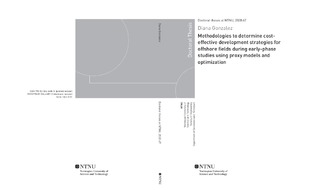| dc.description.abstract | This thesis summarizes research efforts for developing a structured methodology for decision support in feasibility studies and concept planning phases of oil and gas field development. The objective in developing the methodology was to provide an easy-to-use facility to integrate the production-governing elements of oil and gas fields that capture the integrated production and economic performance of the system. This in a modular and scalable manner that includes numerical optimization and uncertainty analyses needed to support engineering decisions. The novelty of the methodology stems from a variety of measures to integrate field architecture, reservoir extraction and production facilities performance in a proxy model, shorten the running time, simplifying the input demands and making an efficient optimization scheme.
To represent the production performance of the integrated production system, a collection of value tables were used, computed from coupled models that included a tank reservoir, wellbore and network. This allowed to estimate production profiles without having to run the coupled model each time target rates are varied. Furthermore, it allowed to capture the effect well and flowline pressure drops have on field performance. Additionally, a proxy model for capital, drilling and operational expenditures was obtained by applying linear regression to data points extracted from a commercial cost estimation software. An optimization problem was then formulated to find production and drilling schedule that maximize NPV. The problem was formulated as a mixed-integer linear problem using SOS2 variables, which allowed low running times. The effect of uncertainty of reservoir size, well productivity, production system layout and costs was evaluated using probability trees.
The methodology was tested on field scale data from the Barents Sea Wisting field, which is currently under predevelopment study phase. The public domain data of the field was sufficient to employ and test the methodology. With regards to production, the Wisting field has distinct characteristics that includes remote location with non-existing infrastructure, low reservoir pressure and temperature and wax deposit tendency.
The results at the end of the study and the testing of the results provide a template and an input for developing a commercial software package for performing structured feasibility studies and concept planning during the engineering design of oil and gas fields.
In order to establish a wider variety of field development scenarios for the particular Wisting field, the research encompassed also a feasibility study of two known flow assurance concepts for control of wax deposition, cold flow and electrical heat tracing. The first study confirmed the feasibility of the cold flow approach for transportation of Wisting-like oil. The second study quantified the economic and technical performance of several configurations of heat tracing element along the pipe and heating schedule when transporting waxy crude oil in the pipeline. Subsequently, the model of the Wisting field case was modified to include the cold flow technology and the methodology for field development decision support was executed. The results of this new analysis confirm that the implementation of cold flow could lead to a modest improvement in the economic outcome of the field. | nb_NO |
